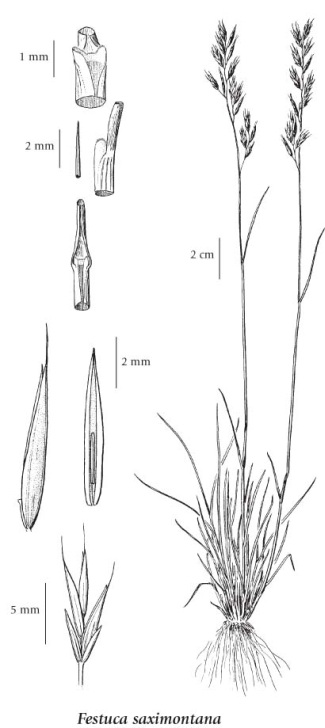Festuca saximontana Rydb.
Rocky Mountain fescue
Poaceae (Grass family)
Introduction to Vascular Plants
Rocky Mountain fescue
Poaceae (Grass family)
Introduction to Vascular Plants
Species Information
General:
Perennial, densely tufted grass from fibrous roots; stems (5) 20-50 (60) cm tall, with visible nodes in taller plants.
Leaves:
Sheaths conspicuous at the base of the stems, persisting for more than 1 year, remaining entire, not shredding into fibres; blades 2-20 cm long, 0.3-0.7 mm wide, stiff, hairlike, folded; ligules 0.1-0.4 mm long.
Flowers:
Inflorescence a narrow panicle, 3-9 (13) cm long, the branches 0.5-3 (5) cm long; spikelets (2-) 3- to 4- (6-) flowered, (3.5) 4.5-9 (10) mm long; lower glumes 1.5-3.5 mm long, the upper ones 2.5-4.8 mm long; lemmas 3-5.6 mm long, awned, the awns 0.5-2 (2.5) mm long; anthers (0.9) 1.2-1.7 (2.1) mm long; ovary tops smooth.
Notes:
F. saximontana var. purpusiana is the name given to plants 8-20 (25) cm tall, in which the stems are less than 2 times the length of the basal tufts. Such plants are found at higher altitudes in more exposed habitats, but do not appear to be genetically distinct. The var. robertsiana, described by Pavlick (1984) from the Rocky Mountains of BC, is intermediate in culm length between the var. purpusiana and var. saximontana and is difficult to distinguish (Aiken 1994).
Illustration

If more than one illustration is available for a species (e.g., separate illustrations were provided for two subspecies) then links to the separate images will be provided below. Note that individual subspecies or varietal illustrations are not always available.
Illustration Source: The Illustrated Flora of British Columbia
Ecology
Ecological Framework for Festuca saximontana
The table below shows the species-specific information calculated from
original data (BEC database) provided by the BC Ministry of Forests and Range.
(Updated August, 2013)
The table below shows the species-specific information calculated from
original data (BEC database) provided by the BC Ministry of Forests and Range.
(Updated August, 2013)
| Site Information |
Value / Class |
||
|
Avg |
Min |
Max |
|
| Elevation
(metres) |
1324 | 410 | 2555 |
| Slope
Gradient (%) |
21 | 0 | 104 |
|
Aspect (degrees) |
196 | 0 | 360 |
| Soil
Moisture Regime (SMR) [0 - very xeric; 4 - mesic; 8 - hydric] |
2 | 0 | 7 |
| Modal
Nutrient Regime
Class |
C | ||
| #
of field plots species was recorded in: |
777 | ||
| Modal
BEC Zone Class |
IDF | ||
|
All BEC Zones (# of stations/zone) species was recorded in |
AT(14), BAFA(28), BG(29), BWBS(14), CWH(1), ESSF(143), ICH(14), IDF(269), IMA(15), MH(4), MS(93), PP(13), SBPS(61), SBS(41), SWB(15) | ||
|
Source:
Klinkenberg 2013
|
|||
Habitat and Range
Mesic to dry meadows, grasslands, rocky slopes and ridges and forest openings in the montane to subalpine zones; common in S BC in and E of the Coast-Cascade Mountains, infrequent in SW and N BC; N to AK, YT, NT, E to NF and S to NY, MI, WI, IA, KS, NM, AZ and CA.Status Information
| Scientific Name | Origin Status | Provincial Status | BC List (Red Blue List) | COSEWIC |
|---|---|---|---|---|
| Festuca saximontana var. purpusiana | Native | S5 | Yellow | Not Listed |
| Festuca saximontana var. robertsiana | Native | S4? | Yellow | Not Listed |
| Festuca saximontana var. saximontana | Native | S5 | Yellow | Not Listed |
BC Ministry of Environment: BC Species and Ecosystems Explorer.
Synonyms
Synonyms and Alternate Names:
Festuca saximontana var. purpusiana (St.-Yves) Frederiksen & Pavlick